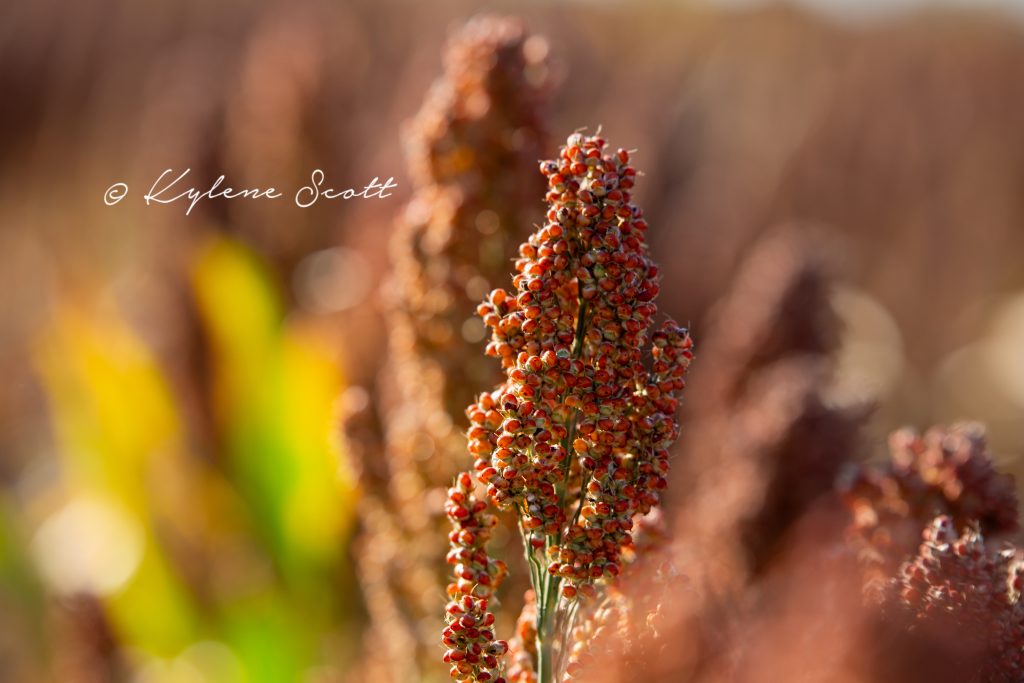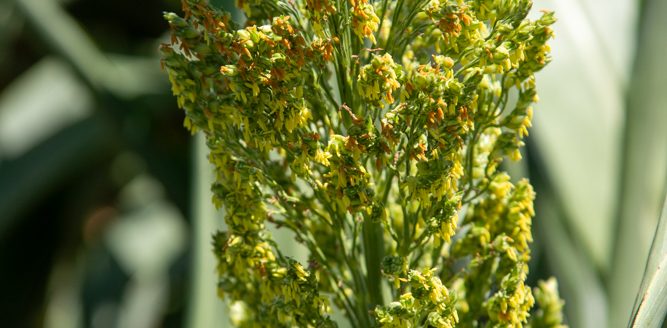Familiar shades of red, orange, yellow and even a few green heads filled a sorghum field just north of Dighton, Kansas. Seed variety signs littered the plot pointing out companies and variety numbers.
This particular site was the location for the Sorghum Connection field day Sept. 11. Two other locations hosted similar events in Russell and Bavaria, Kansas during mid-September. Hosted by the Kansas Grain Sorghum Commission, Kansas State University Department of Plant Pathology and K-State Research and Extension, organizers updated producers on current variety information with hopes to help them improve sorghum yield.
Adam York, administrator for the Kansas Grain Sorghum Commission and staff for the Kansas Sorghum Producers Association, told attendees at Dighton, KGSC is one of five commodity commissions in the state.
“Kansas producers grow the largest sorghum crop in the U.S., and we’re certainly proud of that,” he said. “And here in the backyard in sorghum country in Kansas, we are thrilled to bring in this Sorghum Connection series number two.”
Andy Hineman, on whose farm the plot resides, said he’s been doing hybrid corn and sorghum trials on his farm for at least a half dozen years.
“We’ve got high protein trials in the milo and then population studies too. So it’s all pretty exciting stuff,” he said. “I’m really excited to see and learn a little bit more about what’s been grown in our field. It’s been nice seeing it out here, but actually having them talk through it and explain some of it to me is going to be good.”
Hineman is thankful to see sorghum research happening right in his backyard, and appreciates funding the U.S. Sorghum Checkoff provides. Hineman said his family has used a no-till practice for a number of years on the field the plot was located.
“I’m glad that’s happening. I’m looking forward to continuing that too,” he said.
Brian Lockman is Hineman’s agronomist and he gave additional information about the plots during the morning session.
“These things take a lot of work from beginning to end, and we really try doing it, not just for our benefit, but for everybody,” he said. “What we do is we want to find out what works best in our backyard. You hear a lot of research from places far away, but the best way to get what’s going to work in our environment, our rainfall, we figure, is doing it right here and help everybody.”
The plots were previously in wheat, and seed was planted directly into the wheat stubble. The field had manure applied last fall, with 10 ton applied to the acre and grid sampled on a two and a half acre grid. Nitrogen was later applied on a variable rate basis. Seed numbers were around 32,000 per acre when the Hinemans planted in early June.
“We ended up with a 29,300-stand count,” he said. “After that, planted an inch and three quarter deep, and at that time, the subsoil was 4-foot deep when we started.”
Even before the sorghum went into the ground, the fields were sprayed and between the first spraying and planting they dealt with bindweed. They used a technology that detects brown versus green plant material and only sprays the spots where there are weeds.
The technology has been used effectively the past couple of years and lessens the impact on the environment, Lockman said.
For pre-emergence, Lockman said 1.4 pints of Brawl, a pound of atrazine and 5 ounces of Callisto and a little bit of Dicamba was applied. Around July 2 they came back with another pint of Brawl, ending up with 2.4 pints total.
“This is kind of a good field to show that you can do everything right,” he said. “Sometimes nature just doesn’t cooperate, and you still end up with pigweeds—one of the biggest struggles we’ve got on the varieties.”
Lockman admits they’re pushing the limits a little bit, and the research shows the give and take.
“We really like testing some of the old varieties that have done us good in the field,” he said. “We’ve got years and years of research in our whole field, whole farm data and we lean on our seed guys a lot on their new varieties.”
They’re able to see what new varieties are coming up and what’s the next new product. Lockman likes to compare new varieties against old, tried and true ones and see what’s going to be successful in a full field environment.
Hineman said because of growing season challenges the past couple of years, it’s been really tough for row crops “in this part of the country.”
“So the yields have been really lacking,” he said. “But we still do maintain that database of historical yields. We’ve tried to kind of average our last few trials on some spreadsheets.”
The field was “really hammered with herbicide” because of the field day and Hineman wanted a good, clean field for the trials. However, the pigweeds just weren’t kind to it.
Kylene Scott can be reached at 620-227-1804 or [email protected].





